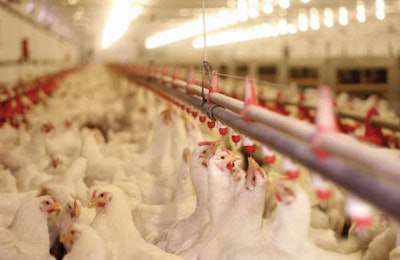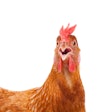
The US egg industry recovered from the avian influenza outbreak, but 2016 challenged the industry with an oversupply situation and a cascade of cage-free egg purchase pledges from major buyers. The 2014-2015 outbreak cost producers about 40 million layers and pullets. In 2016, layer flocks were restocked, shuffling Egg Industry’s Top Egg Company survey rankings.
The Top Egg Company survey is conducted annually, and the results reported are comprised of company-submitted information and estimates made based on input from publicly reported information and industry sources. The survey reports on the number of hens housed on Dec. 31, 2016. The 2017 report includes 63 companies with a collective 313.2 million hens.
Top 5 egg producers
Cal-Maine Foods Inc. and Rose Acre Farms retained the top two positions with 37.94 million and 25 million hens, respectively. Cal-Maine is the world’s largest egg company and Rose Acre is the third largest.
Hillandale, with 18 million layers, moved to the third ranking from the fourth ranking in the 2016 rankings. Versova Holdings LLC, a food company formed in May 2016 to manage the day-to-day operations of Centrum Valley Farms LLP, Trillium Farm Holdings LLC and Iowa Cage-free LLP, moved into the fourth spot with 17.1 million hens. Rembrandt Enterprises rose one spot to the fifth position with 14.7 million hens. Last year, Trillium ranked fifth with 11.4 million hens.
Michael Foods, with 12.96 million layers, fell to the seventh ranking from the third spot.
Recovery from avian flu
Several companies made big jumps in the rankings after restocking regenerated their flocks. Center Fresh Group rose to the No. 8 position from No. 20, with its flock growing to 9.7 million hens from 4.8 million last year. Rembrandt’s flock is now larger than its post-avian flu outbreak amount of 11.06 million hens housed. Sunrise Farms Inc. jumped to No. 21 from No. 52 with an increase of 3.1 million hens. Dakota Layers, with no hens at the end of 2015, didn’t begin restocking until January 2016. It rose to No. 55 with 1.1 million hens.
The avian influenza crisis drove up egg prices as the supply shrunk and remained smaller than usual, but in December 2016 Cal-Maine CEO Dolph Baker said the egg industry is now facing an oversupply situation. In a quarterly statement, Baker said egg producers are restocking hens and populations are near pre-outbreak levels, but demand for eggs is not keeping pace with the increased supply. Whether the outbreaks of avian flu in Europe, Asia and South America at the end of 2016 and beginning of 2017 will change this situation remains unknown.
Other movement in the rankings
Minnich Poultry rose to No. 32 from No. 40 with an increase of about half a million hens. Wenger Feeds/Dutchland Farms increased to No. 33 from No. 57 with an increase of 1.42 million hens. Pearl Valley Eggs dropped to No. 57 from No. 29 with a decline of 600,000 hens, industry sources report that the company is transitioning to cage-free production.
Additions to the rankings
Four egg producers are added to the Top Egg Company rankings this year: Midwest Specialty Egg LLC, with 3.9 million hens; Chino Valley Ranchers/MCM Poultry, with 1.85 million hens; The happy egg co., with 700,000 hens; and Weber Family Farms with 400,000.
Chino Valley Ranchers and The happy egg co. both focus on specialty eggs. Chino Valley – based in Colton, California – produces cage-free, free-range, organic and nutritionally enhanced eggs. The happy egg co., based in San Francisco, produces free-range eggs. It is the US operation of British egg producer Noble Foods. Noble is one of the largest egg producers in Europe.
Mergers, partnerships and expansions
To meet the challenge of cage-free or other non-conventional production, many producers are pooling their resources to boost production. Others are expanding cage-free production by building new cage-free houses or replacing existing complexes with cage-free housing.
Cal-Maine and Rose Acre continue to work together to develop a cage-free egg facility near Bogata, Texas, capable of housing 1.8 million birds. Hickman’s Egg Ranch is working with Opal Foods to develop four farms, capable of housing a total of 10 million cage-free birds, by 2020. The first farm near Wasco, California, is expected to open in early 2017. Weaver Brothers and Cooper Farms opened two, new organic, cage-free egg farms in 2016. The pair plan to open two more new farms in the near future.
Hillandale is replacing aging cages with cage-free housing and planning on building new cage-free houses in Hicksville, Ohio, and Bozrah, Connecticut, by the end of 2017. Rembrandt is planning on building a cage-free production site, capable of housing about 3 million birds, at an existing facility in Lake Preston, South Dakota. Michael Foods is converting a farm in Bloomfield, Nebraska, into a cage-free operation. Herbruck’s Poultry Ranch is planning on adding cage-free housing for as many as 2.4 million hens. Gemperle Farms plans on converting all of its operations to cage-free. Its layer flock includes 4.91 million hens.
As always, mergers and acquisitions are part of the business. Cal-Maine Foods acquired Dixie Egg Co. – No. 25 with 3.09 million layers in the 2015 rankings – at the end of 2016. In February 2016, Michael sold Michael Foods Canada (MFI Food Canada) to Burnbrae Farms, Canada’s largest producer of table eggs.
Industry attitudes on expansion
Egg producers were asked to report expansion projects undertaken in 2016 as well as any conversions of cage housing to cage-free. In this year’s survey, In 2016, four producers converted housing for 2.7 million caged hens into housing for 1.9 million cage-free hens. In 2017, six producers plan on converting housing for 2.9 million caged hens into housing for 2.6 million caged hens.
In 2016, 15 egg producers reported adding housing for a total of 7.5 million hens. Egg producers also report recaging housing for 1.0 million hens last year.
According to the survey responses, 14 egg producers plan on adding cage-fee housing for a collective 4.7 million hens in 2017. The reported increases in cage-free hens varied from as few as 30,000 to as many as 950,000 birds. There is not much expansion planned outside of cage-free housing, with one survey repsondent reporting plans to add 0.4 million spaces for cage houses hens in 2017.
Survey repsondents report intentions to add a total of 7.6 million additional hens in 2017, and this includes a combination of hens in housing constructed in 2016 but not yet stocked as well as housing contructed and stocked in 2017.
















